- Best LinkedIn Learning Courses (Lynda Courses) - March 31, 2020
- EdX vs Coursera: Which is the Better Online Platform? - March 24, 2020
- Best Online Bookkeeping Courses Worth Taking - March 24, 2020
Did you know that only 21% of all Americans can speak more than one language?
If you’re among the 21% of U.S.-based polyglots, congratulations! For those of you who can only communicate in English, no need to despair.
Yes, it’s true that adults have a harder time picking up languages than young children.
However, as difficult as it may be, it’s not impossible for adults to learn a second, third, or fourth language.
Today, a classroom isn’t required to study a language (or anything else, for that matter). All you need is an electronic device, maybe a nominal fee, and most importantly, an ability to open your mind and learn as much as possible, even if it means making mistakes.
Visit your app store of choice and you’ll find a plethora of language-learning software. Some certainly stand out among the rest; here, we’ll be looking at Memrise vs Duolingo – two of the highest-rated programs available today!
 Meet Memrise
Meet Memrise
Memrise was released in 2008, and has since become a well-decorated language learning app. It won Best App at the 2017 Google Play Awards, while also topping Best Apps for iPhone / iPad lists in nearly 20 countries (most of them in Europe).
The East London-based Memrise now boasts more than 200 online courses across 27 languages. It serves approximately 27 million users, per its homepage.
Memrise’s methods are deeply rooted in three scientific principles, which are presented as fun games-based exercises and botany-and-space-themed progress indicators. (As Memrise puts it: “Your memory is a garden, not a storehouse.”)
The app is geared toward those who want to learn a language, but don’t have the time to devote hours to full-on instruction (see: adults who work full-time or busy parents). A few minutes a day – say, during commutes to or from work – is all that’s needed.
Memrise doesn’t only specialize in language; it also offers courses across a wide spectrum of interests, from Arts & Literature to Math & Science.

Meet Duolingo
Duolingo arrived several years after Memrise, in 2011, and has made quite an impression since. It’s the most downloaded Education app in the entire world, with over 200 million users and counting. Right now, it offers 27 languages for English speakers to learn, with four more currently in development (including Klingon!).
Based in Pittsburgh, PA, Duolingo was recently valued at $700 million. Its backers include entrepreneur/public speaker/author Tim Ferriss, CapitalG (formerly Google Capital), and actor Ashton Kutcher.
Duolingo’s M.O. is to make language learning personalized, fun, and accessible to all. For anyone wondering if Duolingo’s approach is effective, it has plenty of research on its side to assuage skeptics.
Similar to Memrise, Duolingo is a game-based platform, complete with in-lesson achievements and lifelines (hearts). Also, like Memrise, Duolingo is built as a language-learning resource for those who have lots of ambition but little time: “Learn [language] in just five minutes a day,” it proclaims.
In addition to individual language lessons, Duolingo also provides a school-based version of its software. Other projects include an accredited English-language test and a virtual flashcards app called Tinycards, which can be used for various subjects.
Free or Pay-to-Play
Memrise and Duolingo are free, but each also offers a premium version that comes at a cost.
Memrise Pro
Memrise’s base platform includes over 200 language lessons plus the basic learn & review.
For a price, users can upgrade to Memrise Pro. It offers four tiers of pricing, from monthly ($9/mo.) to lifetime ($149 for everything). Its best offer is its annual plan, which is $4.90/mo. (or $58.80/yr.).
In addition to the base features, Memrise Pro members can enjoy the following benefits:
- Grammarbots and Chatbots (select languages)
- Video mode, complete with native speakers
- Algorithm-based learning, to focus on difficult-to-learn phrases
- Offline mode
You can either upgrade in-app or via Memrise’s Web site.
Duolingo Plus
Duolingo’s base platform features ads at the end of each lesson, to monetize its free service. Upgrading to Duolingo Plus will not only remove ads but also allow for all lessons to be available offline (as opposed to just the user’s current lesson).
Three pricing tiers are available:
- One month: $9.99/mo.
- Six months: $7.99/mo. (its most popular plan)
- 12 months: $6.99/mo.
You can either upgrade in-app or via Duolingo’s Web site.
In-app purchases are also available; however, these don’t require real money, but Duolingo’s own currency, red gems known as Lingots. These are earned by completing challenges. Use Lingots to purchase power-ups, such as a Streak Freeze, or to buy costumes for the app’s green owl mascot, Duo.
Is it worth the upgrade?
Memrise Pro certainly makes for a more features-rich experience. At only $5/mo., it’s a worthy investment for those who want to take their language learning to another level by homing in on troublesome vocabulary and grammar, utilizing AI, and having lessons on-the-go, regardless of WiFi connection.
As for Duolingo Plus: Unless the user absolutely despises ads and wants access to all lessons offline, it’s not a necessity. The freemium product is already abundant in features. To put an altruistic spin on it, paying for a Duolingo Plus subscription will “support the mission,” as the app puts it, and continue to fund research and other projects.
How to Get Started
The Memrise vs Duolingo comparison starts to differ with their onboarding processes and customizable goal settings.
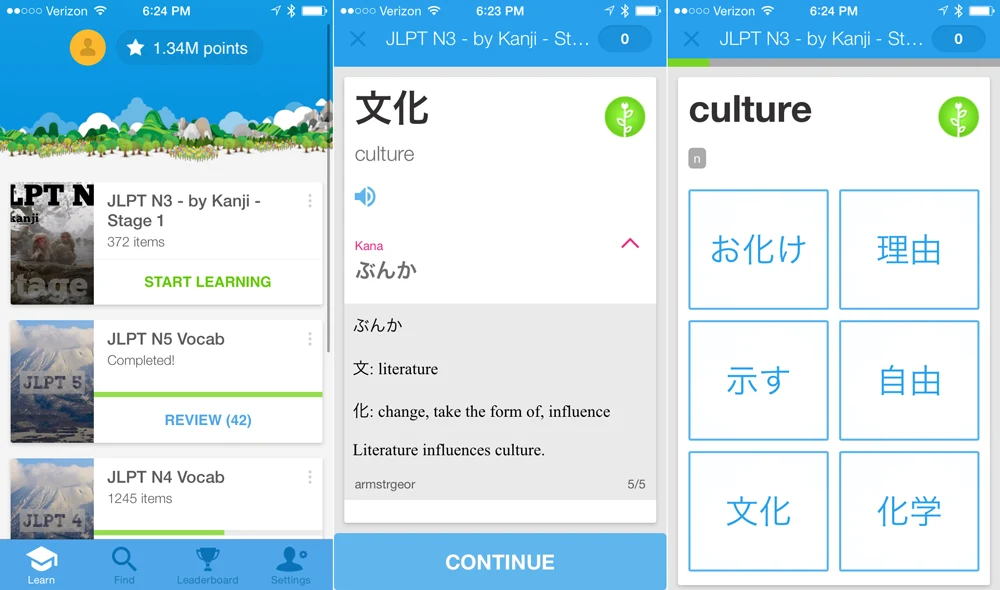
Welcome to Memrise
All languages in Memrise begin with the Launchpad, which features basic phrases (such as greetings). Beyond that, the following lessons can vary depending on the language. For example, Lesson 2 for learners of French involves a basic grammar lesson with one of the Grammarbots, while Lesson 2 for Japanese learners revolves around learning the sounds of hiragana.
For anyone who is using Memrise as a way to revive latent language skills, users can scroll up and skip ahead to more advanced lessons. Corresponding tests will remain locked until the lessons are completed.
Users can set daily goals based on how many words they’d like to learn per day: 5, 15, or 30. They can also tailor their individual lessons to learn as many as 10 words per lesson and review up to 50 words per session.
Select languages have an introductory Chatbot that serves to gauge a user’s demographics, reason for learning their desired language, and how they found out about Memrise. It’s primarily conducted in English.
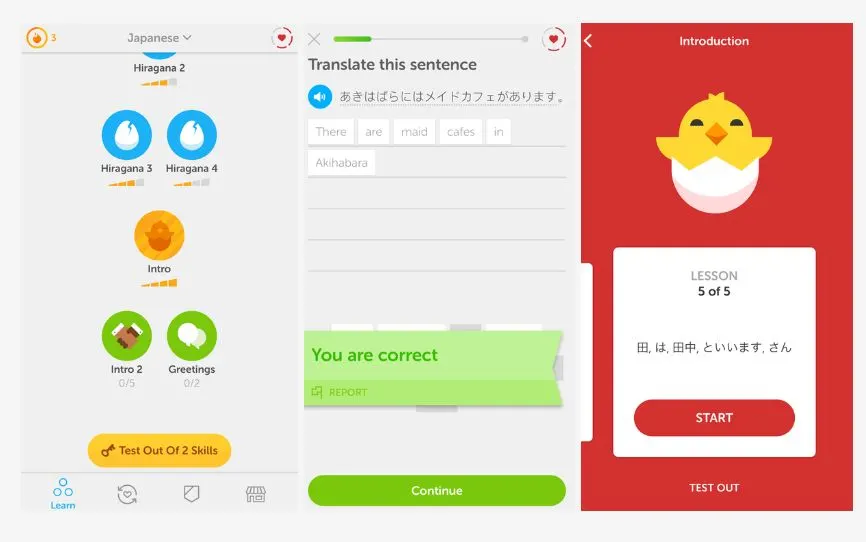
Welcome to Duolingo
Duolingo’s onboarding process is much more uniform than Memrise’s. Upon selecting a language, Duolingo offers the option to either learn the basics or test out of the elementary levels via a 5-minute placement test. The latter Is an enticing option for anyone who is picking up Duolingo to brush the dust off of their foreign language skills.
If a user feels like the level at which Duolingo has placed them is too low, they can opt to take shortcuts to advance lessons sooner.
Users can set a daily goal in accordance with XP (“experience points”), ranging from Casual (10 XP per day) to Insane (50 XP per day).
Which is more welcoming?
The ability to test existing language skills and place out of lessons that may be too basic or boring is a point in Duolingo’s favor. While Memrise also allows for some floating around, it’s less regimented than Duolingo’s approach. Anyone who is seeking as close to formal, organized language instruction as possible may prefer Duolingo.
As for goal-setting, Memrise emphasizes total vocabulary learned, whereas Duolingo focuses on the totality of instruction via XP. Neither is right or wrong, but the usefulness of either will depend on what’s more important to the learner.
Pros and Cons
In which areas do each of these language apps excel, and where may they fall short?
The Pros of Memrise
The Methodology: Memrise’s presentation of vocabulary combined sound clips from native speakers aids in committing words to memory. The sequence of words presented in the review sessions may seem terribly repetitive, but to borrow some of Memrise’s metaphors, it’s effective in sowing the seeds of language acquisition…as long as you use the app consistently.
The Interface: The Memrise app is colorful, fun, and straightforward. The Home menu is designed to look like outer space, with the primary lesson dubbed the “Launchpad.” As you level up with each lesson, your Ziggy in the top-left corner – described as “an embodiment of all that is good in the multiverse” – will evolve.
Vocabulary Lists: These lists allow you to tailor your experience to your specific needs. Instead of starting from zero, you can focus on words and phrases that are best for business settings, interacting with family members, or enjoying TV and cinema. There are also lists that are designed with language aptitude tests in mind, such as the TOEFL (for non-native speakers of English).
The Cons of Memrise
The Quality of Content: Memrise relies a lot on user-based content, from custom vocabulary lists to Mems, which are built-in flashcards that provide additional context to vocabulary, such as mnemonics and literal translations. Many of them are useful, but a good number of them…clearly aren’t:
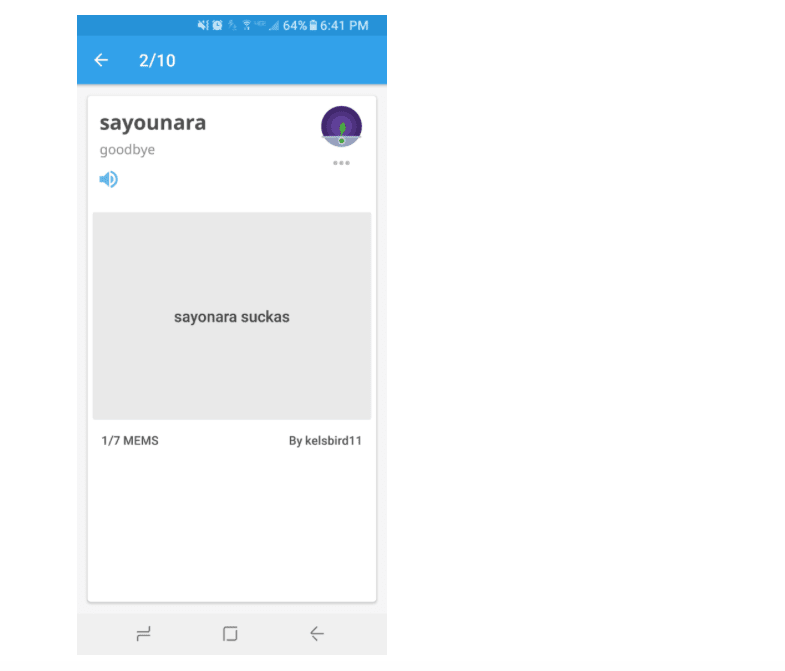
A Lack of Uniformity: This ties into the above point. Because there is a lot of user-created content, learning experiences will differ among the languages offered. Some programs are fleshed out better than others – romance languages like Spanish, French, and Italian may be the strongest courses on offer right now.
Lack of Access to Extra Courses In-App: In the Memrise app, select “Learn another course,” and then go to “I want to learn…” As mentioned earlier, Memrise offers lessons in several non-language disciplines, such as Math & Science, Entertainment, and History & Geography. However, this is what comes up for nearly every category:

Go to Memrise’s Web page and you will find these courses easily, but the inability to add them in-app is inconvenient. You must add these extras through your browser, and then they’ll be available in the app. (Unfortunately, this also rings true for vocabulary lists – they can only be found and added via a Web browser.)
The Pros of Duolingo
The Presentation: Duolingo is polished and well-designed. The interface is easy to maneuver, and the progression of each lesson is clearly outlined. Every language follows the same basic outline. It features bright and cheerful colors, with the cartoonish owl Duo cheering you on every step of the way.
Consistency in Quality: This ties in to the previous point of every language following the same general path to progression. However, user-created content is absent. As Duolingo’s staff is exclusively producing these lessons, there is no noticeable drop in standards among languages. Beta languages (such as Korean) may have some kinks to work out, but that’s to be expected during testing versions.
A Focus on Weakest Words: Within each lesson, Duolingo keeps tabs on which words are your weakest – the vocabulary you kept getting incorrect during review sessions. At the end of every lesson is a tab featuring these “weak words,” which you can then focus on exclusively.
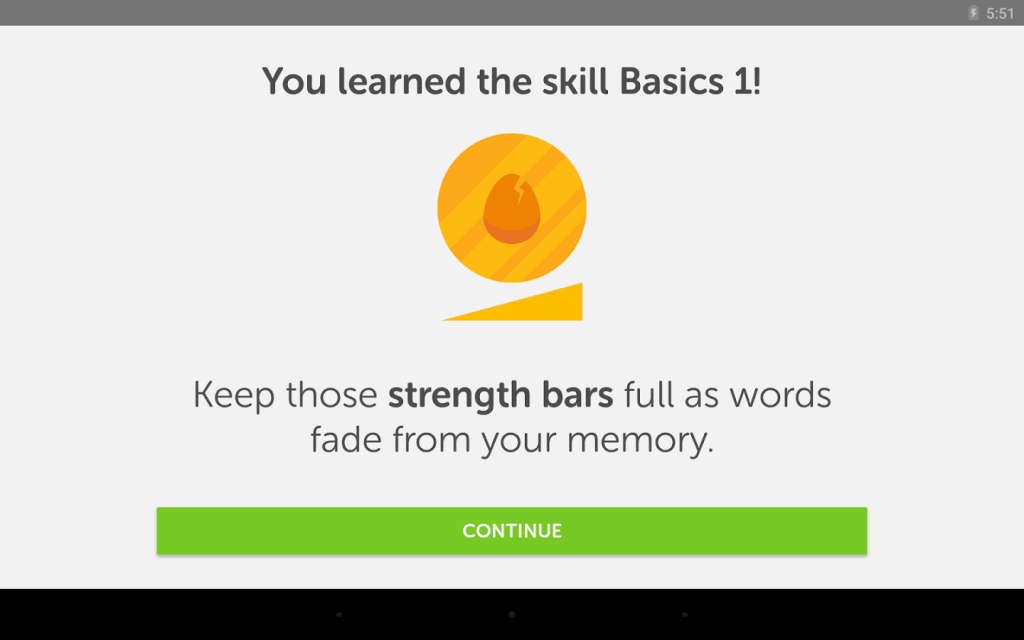
Memrise’s Pro version has a similar feature using algorithms, but Duolingo offers this service for free.
Fluidity in Translations: One of the common exercises offered by Duolingo is the ability to translate sentences, either by selecting the correct words from a group or going exclusively by memory. In many cases, Duolingo will be forgiving if a translation isn’t an exact match with what is considered correct. Proper grammar is still expected, however.
Robust for a Freemium App: While there are perks to upgrading to Duolingo Plus, the base app is flush with content already. If it’s important to you to have access to back lessons without WiFi, then consider upgrading. Otherwise, you’re fine with the base product.
The Cons of Duolingo
Clubs: Duolingo Clubs are supposed to serve as a way for other language around the world learners to motivate one another, via leaderboards. However, it only allows for people to comment on others’ progress via a small selection of canned responses:
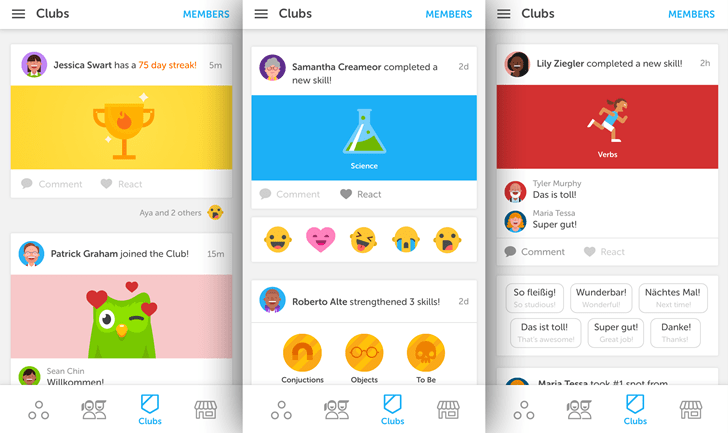
This is a missed opportunity for language students to practice what they’ve learned, as it robs them of the ability to freely express themselves based on what they’ve already learned.
Weird Sentences: Duolingo doesn’t take itself seriously, and that’s certainly not a bad thing. However, it is known for springing upon its users some…questionable phrases. To call it a “con” may be a stretch, but they’re not necessarily practical phrases. A Twitter account dedicated to these awkward sentences exists.
Memrise vs Duolingo… And the Winner is:
…Duolingo.
If you want to rely on a single language app to help you acquire a new language or revive skills in a latent one, make Duolingo your choice.
Why? There are two points that give Duolingo the edge over Memrise:
- As a freemium app, Duolingo is more robust
- The overall quality of Duolingo’s content is much higher and more cohesive
That said, Memrise is not a bad app by any means! It’s more customizable and fluid than Duolingo, which is ideal for anyone who doesn’t require a regimented learning experience, or only needs to learn a few words and phrases for a short amount a time (like a business trip). Of course, if you upgrade to Memrise Pro, you’ll be privy to extra features that will enrich your experience, but it won’t completely eradicate the issues that are present in the free version.
However…
…if you want to up the ante on your language learning, it’s entirely possible, and even preferred, to use both platforms.
Rely on Duolingo for more organized and uniform instruction, with an added focus on sentence structure.
Look to Memrise for boosting vocabulary and a more fluid learning experience.
Count on both apps to provide some fun and friendly self-competition, in just minutes a day.
Happy language learning!
| Memrise | Duolingo | |
| Pricing options | Free, with plans from $9/mo. to $149 for lifetime access | Free, with monthly plans from $9.99/mo. |
| Number of Languages Offered | 27, with over 200 courses available | 27, with four currently in beta |
| Number of Users | Approximately 27 million | Over 200 million |
| Key Features |
|
|
| Offline Access | Yes, all lessons via Memrise Pro subscription | Yes, all lessons via Duolingo Plus; current lesson only via freemium version |
| Cute Mascots | Ziggy, who evolves with every level you unlock | Duo, who can change outfits via in-game currency |
| Conclusion | Ideal for vocabulary and a more fluid experience | Best for a more well-rounded, organized experience |

